| Gabrielle Moser is running an interesting series on her blog, an "informal archive of Canadian curated moments put together by Canadian curators from across the country." She's invited curators to list 5 curated shows that had an impact on them. I decided to do one of my own. So here goes... |
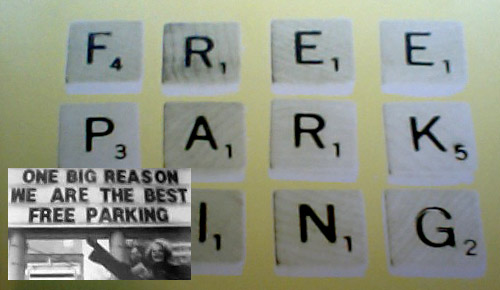
1) Free Parking Gallery (1996-1997)
curators: Michael Buckland, Jill Henderson, Anda Kubis
artists: Heather Allen, Julie Arnold, Louise Bak, Alan Belcher, Adrian Blackwell, William S. Brown, Peter Bryne, Michael Buckland, Neil Burns, Patriciu Calimente, James Carl, Roger Carter, Corinne Carlson, Carlo Cesta, Dave Clark, Don Collins, Reid Diamond, Rebecca Diederichs, Jerry Drozdowsky, Same Easterson, Pate Ellis, Kate Farrell, FASTWÜRMS, Bud Fujikawa, Eric Glavin, Lee Goreas, Janice Gurney, Sarah Hartland Rowe, Ken Hayes, Sue Havens, Greg Hefford, Jill Henderson, Karen Henderson, Alexander Irving, Luis Jacob, Luis Jacob & Andrew Power, Maura Jasper, Lisa Johnson, Susan Kealey, Robert Kennedy, Jinhan Ko & Gillian Frise, Nestor Kruger, Anda Kubis, Carter Kustera, Stacey Lancaster, Olga Lysenko, Daniel Lui, Kristin Lucas, Patrick Macaulay, Euan Macdonald, John Marriott, Dave McFarlane, Greg McHarg, Joe McKay, Sally McKay, Jennifer McMackon, Matt Meagher, Shanna Miller, Lorna Mills, Regan Morris, Lisa Neighbour, Jack Niven, Nathalie Olanick, Daniel Olson, Laura Parnes, Holly Polly, Marina Polosa, Coman Poon, Andy Patton, Heather Raymont, Brent Roe, Liz Rosch, Mario Scattaloni, Brian Scott, Dave Shrigley, Molli Simon, Carl Skelton, Matthew Sloly, Ben Smith Lea, Andrew Szatmari, Ho Tam, Laura Teneycke, Kika Thorne, Hendrika Sonnenburg & Chris Henson, R.M. Vaughan, Liselot van der Heijden, Neil Weirnik, Norman White, Kil-young Yoo
Jennifer at simpleposie and I were chatting IRL about Free Parking Gallery the other day. It was a one-year curatorial experiment that had an enormous impact on artists of my generation in Toronto. By renting a raw space, shamelessly putting themselves in their shows, curating a whole pile of artists they liked, and providing free beer at openings, Free Parking showed me and my artist peer group that we could create our own discourse based around the practical-yet-radical assumptions that other people's art is exciting and putting on art shows is fun. It was a massive influence on Lola magazine, which we started up pretty soon after Free Parking shut down. Every generation of artists has to find a way to articulate their own context. Free Parking Gallery showed that generous, DIY, artist-initiated curation is a darn good way to go about it. |
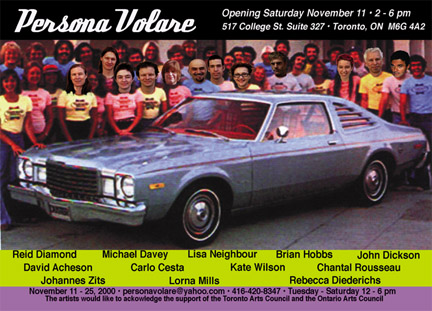
2) Persona Volare (2000-ongoing)
artists/curators: David Acheson, Carlo Cesta, Michael Davey, Reid Diamond, John Dickson, Rebecca Diederichs, Brian Hobbs, Lorna Mills, Lisa Neighbour, Chantal Rousseau, Lyla Rye, Kate Wilson, Johannes Zits
Persona Volare is a large, self-curating, artists' collective. I love this model. Before all the unused buildings in downtown Toronto were razed for condos, the city was bubbling over with artist collectives who would rent big temporary spaces and set up huge, rangey, diverse exhibitions. Nether Mind and Chromosome were famous ones, but I arrived in Toronto about a minute too late to catch that action. I remember Mud, Spontaneous Combustion, The Sex Show. Heather Nicol's big group shows at the Shaw Street school and Wallace Studios are reminiscent of that time. Persona Volare's first two shows, in 2000 & 2003, happened at the tail end of available real estate. They took place in an empty office building on College Street. Since then, they have shown together at the Canadian Cultural Centre in Paris, Rodman Hall in St. Catherines, the Tree Museum in Gravenhurst, and the Tom Thomson Art Gallery in Owen Sound. I love the self-organised nature of Persona Volare. I'm impressed that a group that large has lasted this long. Emergent, consensual administration can be a nightmare, but there's something about this group that seems to click. The exhibitions hold together through a kind of organic dynamic. The works are always diverse and they resonate well with one another, but never in an over-determined way. The collective doesn't seem to worry too much about articulating why they are together in a curatorial sense — they just are, and it works. |
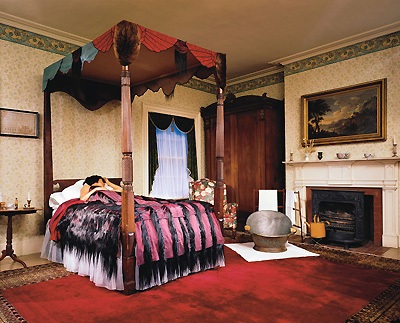
3) House Guests: Contemporary Artists in the Grange (2001)
curators: Jessica Bradley, Christina Ritchie, Jenny Rieger
artist: Rebecca Belmore, Robert Fones, Luis Jacob, Elizabeth LeMoine, Josiah McElheny, Elaine Reichek, Christy Thompson
I feel badly for the AGO. Even now, post-Transformation, the place sometimes feels haunted by the Boultons, that multi-generational Family Compact brood of social-climbing dunderheads who used to own The Grange. I sometimes think the best thing that could happen to the AGO would be to bulldoze The Grange and replace it with a skate park. Next best thing was the exhibition House Guests, where contemporary artists were invited to infiltrate the mansion. One of my favourite pieces was Rebecca Belmore's Wild — in which she made up the master bed with animals skins and slept on them. Her visceral presence as a First Nations woman in the master bedroom of The Grange made a simple statement—Aboriginal Canadians have been made invisible by British Canadians. The other overtly political work was Luis Jacob's In All Directions. Jacob invented an 'angel' out of lights that was dashing through the parlour, trying to get out. In the catalogue Jacob suggests that “It may indeed be more accurate to view the [AGO] itself as an annex to the Grange — as the gallery is linked architecturally and ideologically to the house from which it originated. These roots are nourished and perpetuated by the Gallery through its donated collection and sponsored programming.” House Guests was a brave project, an important piece of self-criticism that could easily have brought the wrath of wealthy patrons down on the gallery's head. It was like a kind of curatorial purge, an attempt to slip away from the clutches of the past. Unfortunately, Toronto's historical roots as a muddy little colony full of self-serving British colonials simply will not go away, and the Grange remains a physical reminder of the ties that bind the AGO to the city's colonial legacies. |
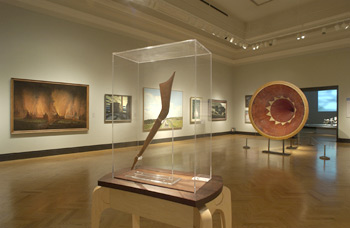
4) Speaking about Landscape, Speaking to the Land, AGO (2005)
curator: Richard William Hill
artists: Rebecca Belmore & canonical Canadian art history greats
Despite ongoing troubles at the AGO, there have been some really excellent and hopeful curatorial developments. In 2005 (pre-Transformation) Richard Hill put Rebecca Belmore's giant megaphone Ayem-ee-aawach Ooma-mowan: Speaking to the Mother, into the middle of a large gallery with paintings by from the Group of Seven, Emily Carr, David Milne, Jack Chambers, Paul Kane, and Cornelius Krieghoff. It was an in-house critique, shaking up traditional approaches to the historic Canadian collection by putting canonical works into a somewhat confrontational conversation with a contemporary First Nations artist. It was a powerful curatorial statement about the ways that museums shape historical narrative. Happily, the AGO has continued this trend post-Transformation, and Gerald McMaster's curation of the JS McLean wing puts a number of works by First Nations artists in direct conversation with the works from the colonial cannon. You can still hear the ghosts of the Boultons rattling their chains, but at least in this wing of the Gallery they aren't setting the agenda. |
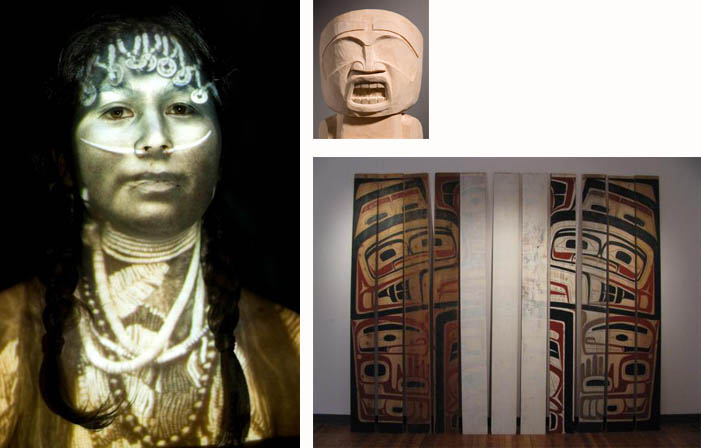
5) past now, MacLaren Art Centre (2010)
curators: Lisa Myers and Suzanne Morissette
artists: Meryl McMaster and Luke Parnell
Lisa Myers and Suzanne Morissette are emerging curators with a kick-ass exhibition under their belts. past now is on view at the MacLaren Art Centre in Barrie until Feb.21. The way that these artists' works speak to one another demonstrates a fine-tuned curatorial sensibility. Both Parnell and McMaster are really technically skilled, and the aesthethic clout of their work is really satisfying. And both of them are making very nuanced statements about the conflicted role of traditional craft practices and representations in First Nations art history. McMaster uses digital photography (but no photoshop) to create eerie layered portraits that reclaim a kind of Romantic image of the Indian from Colonial history. Parnell is a wood carver who situtates himself firmly within the tradition of the great West Coast carvers, yet his pieces are very of-the-moment and potent with a personal/political historical narrative. The exhibition is eloquently speaking to a past, now, without making any essentialist claims nor giving pedantic, didactic lectures. Either artist on their own would be wonderful to see, but placed together, their conversation resonates and grabs you by the throat. |

Bonus (6) Unreal, York Quay Galleries at Harbourfront Centre (2010)
curator: Patrick Macaulay
artists: Tyler Clark Burke, Jason Dunda, Christy Langer, Sto, Jennifer Rose Sciarrino, Jennie Suddick, the slomotion, Jason van Horne
I pick this engaging and utterly contemporary little exhibition in the vitrines at York Quay Galleries as a typical example of the ongoing curatorial brilliance of Harbourfront Centre's Patrick Macaulay. Disclaimer: I have co-curated an exhibition with Patrick that is also currently on view at York Quay Galleries so I'm biased. But I have seen Macaulay's curatorial brain in action and it is an awesome process to behold. He has a giant and ever-growing rolodex of contemporary Canadian artists in his head. His light yet poignant thematic touch creates the kind of dynamic discourse that makes exhibitions into idea-producing engines. He is dedicated to engaging with his public, which represent an unchartably vast demographic. Macaulay's exhibitions speak to art world experts and un-art-initiated audiences of all ages. The York Quay Galleries, comprised of many very public exhibition spaces, is veritable hive of contemporary art activity. |
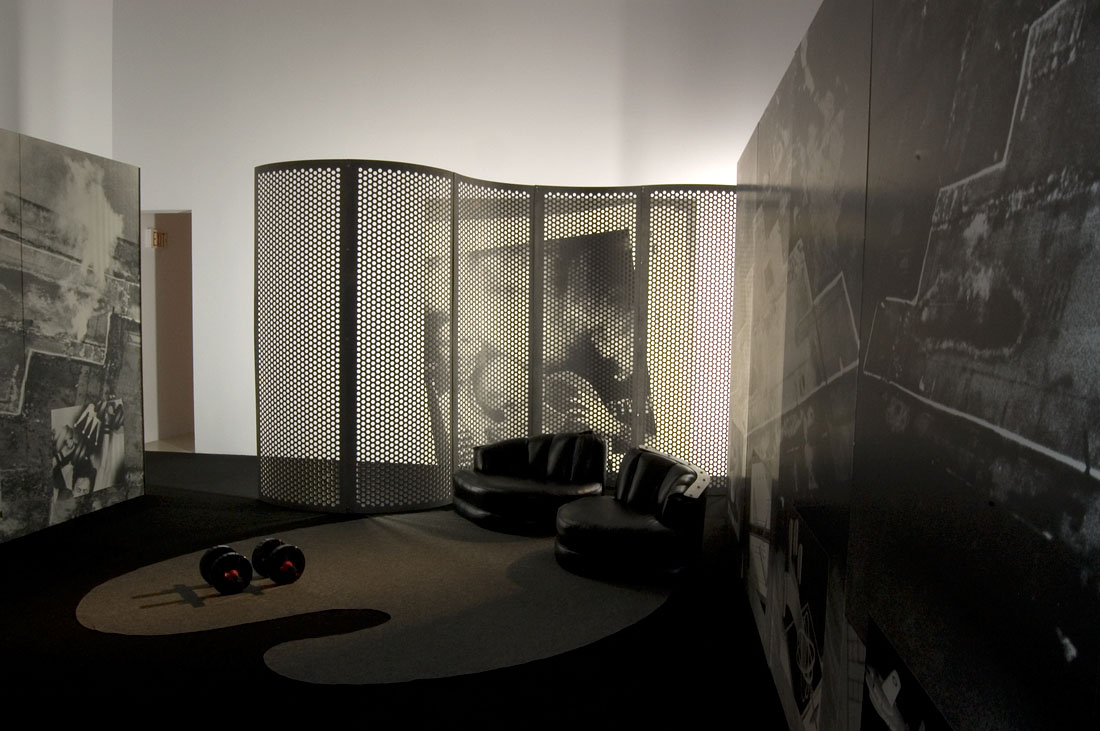
Bonus (7):The 1984 Miss General Idea Pavillion at AGYU (2009)
curator: Philip Monk
artists: General Idea
Philip Monk can be pretty funny. His re-staging of two 1970s exhibitions by General Idea was contextualized as an historical tongue-in-cheek collaboration with the artists. It was humourus and exciting in a time-travel kind of way. I was too young to be there for General Idea, and the show was like a little window into an influential piece of the past. It was great to take my class of Canadian art history students there and watch them try to sort it out. They looked pretty puzzled, and I imagined that's just how people must have looked in the 70s too, when they were trying to parse the fact/fiction dynamics of General Idea's installations. Monk's layered histories worked simultaneously as a recorded document and an in-the-moment art experience, a real curatorial coup. |
|
curators: Michael Buckland, Jill Henderson, Anda Kubis
artists: Heather Allen, Julie Arnold, Louise Bak, Alan Belcher, Adrian Blackwell, William S. Brown, Peter Bryne, Michael Buckland, Neil Burns, Patriciu Calimente, James Carl, Roger Carter, Corinne Carlson, Carlo Cesta, Dave Clark, Don Collins, Reid Diamond, Rebecca Diederichs, Jerry Drozdowsky, Same Easterson, Pate Ellis, Kate Farrell, FASTWÜRMS, Bud Fujikawa, Eric Glavin, Lee Goreas, Janice Gurney, Sarah Hartland Rowe, Ken Hayes, Sue Havens, Greg Hefford, Jill Henderson, Karen Henderson, Alexander Irving, Luis Jacob, Luis Jacob & Andrew Power, Maura Jasper, Lisa Johnson, Susan Kealey, Robert Kennedy, Jinhan Ko & Gillian Frise, Nestor Kruger, Anda Kubis, Carter Kustera, Stacey Lancaster, Olga Lysenko, Daniel Lui, Kristin Lucas, Patrick Macaulay, Euan Macdonald, John Marriott, Dave McFarlane, Greg McHarg, Joe McKay, Sally McKay, Jennifer McMackon, Matt Meagher, Shanna Miller, Lorna Mills, Regan Morris, Lisa Neighbour, Jack Niven, Nathalie Olanick, Daniel Olson, Laura Parnes, Holly Polly, Marina Polosa, Coman Poon, Andy Patton, Heather Raymont, Brent Roe, Liz Rosch, Mario Scattaloni, Brian Scott, Dave Shrigley, Molli Simon, Carl Skelton, Matthew Sloly, Ben Smith Lea, Andrew Szatmari, Ho Tam, Laura Teneycke, Kika Thorne, Hendrika Sonnenburg & Chris Henson, R.M. Vaughan, Liselot van der Heijden, Neil Weirnik, Norman White, Kil-young Yoo
Jennifer at simpleposie and I were chatting IRL about Free Parking Gallery the other day. It was a one-year curatorial experiment that had an enormous impact on artists of my generation in Toronto. By renting a raw space, shamelessly putting themselves in their shows, curating a whole pile of artists they liked, and providing free beer at openings, Free Parking showed me and my artist peer group that we could create our own discourse based around the practical-yet-radical assumptions that other people's art is exciting and putting on art shows is fun. It was a massive influence on Lola magazine, which we started up pretty soon after Free Parking shut down. Every generation of artists has to find a way to articulate their own context. Free Parking Gallery showed that generous, DIY, artist-initiated curation is a darn good way to go about it.
artists/curators: David Acheson, Carlo Cesta, Michael Davey, Reid Diamond, John Dickson, Rebecca Diederichs, Brian Hobbs, Lorna Mills, Lisa Neighbour, Chantal Rousseau, Lyla Rye, Kate Wilson, Johannes Zits
Persona Volare is a large, self-curating, artists' collective. I love this model. Before all the unused buildings in downtown Toronto were razed for condos, the city was bubbling over with artist collectives who would rent big temporary spaces and set up huge, rangey, diverse exhibitions. Nether Mind and Chromosome were famous ones, but I arrived in Toronto about a minute too late to catch that action. I remember Mud, Spontaneous Combustion, The Sex Show. Heather Nicol's big group shows at the Shaw Street school and Wallace Studios are reminiscent of that time. Persona Volare's first two shows, in 2000 & 2003, happened at the tail end of available real estate. They took place in an empty office building on College Street. Since then, they have shown together at the Canadian Cultural Centre in Paris, Rodman Hall in St. Catherines, the Tree Museum in Gravenhurst, and the Tom Thomson Art Gallery in Owen Sound. I love the self-organised nature of Persona Volare. I'm impressed that a group that large has lasted this long. Emergent, consensual administration can be a nightmare, but there's something about this group that seems to click. The exhibitions hold together through a kind of organic dynamic. The works are always diverse and they resonate well with one another, but never in an over-determined way. The collective doesn't seem to worry too much about articulating why they are together in a curatorial sense — they just are, and it works.
curators: Jessica Bradley, Christina Ritchie, Jenny Rieger
artist: Rebecca Belmore, Robert Fones, Luis Jacob, Elizabeth LeMoine, Josiah McElheny, Elaine Reichek, Christy Thompson
I feel badly for the AGO. Even now, post-Transformation, the place sometimes feels haunted by the Boultons, that multi-generational Family Compact brood of social-climbing dunderheads who used to own The Grange. I sometimes think the best thing that could happen to the AGO would be to bulldoze The Grange and replace it with a skate park. Next best thing was the exhibition House Guests, where contemporary artists were invited to infiltrate the mansion. One of my favourite pieces was Rebecca Belmore's Wild — in which she made up the master bed with animals skins and slept on them. Her visceral presence as a First Nations woman in the master bedroom of The Grange made a simple statement—Aboriginal Canadians have been made invisible by British Canadians. The other overtly political work was Luis Jacob's In All Directions. Jacob invented an 'angel' out of lights that was dashing through the parlour, trying to get out. In the catalogue Jacob suggests that “It may indeed be more accurate to view the [AGO] itself as an annex to the Grange — as the gallery is linked architecturally and ideologically to the house from which it originated. These roots are nourished and perpetuated by the Gallery through its donated collection and sponsored programming.” House Guests was a brave project, an important piece of self-criticism that could easily have brought the wrath of wealthy patrons down on the gallery's head. It was like a kind of curatorial purge, an attempt to slip away from the clutches of the past. Unfortunately, Toronto's historical roots as a muddy little colony full of self-serving British colonials simply will not go away, and the Grange remains a physical reminder of the ties that bind the AGO to the city's colonial legacies.
curator: Richard William Hill
artists: Rebecca Belmore & canonical Canadian art history greats
Despite ongoing troubles at the AGO, there have been some really excellent and hopeful curatorial developments. In 2005 (pre-Transformation) Richard Hill put Rebecca Belmore's giant megaphone Ayem-ee-aawach Ooma-mowan: Speaking to the Mother, into the middle of a large gallery with paintings by from the Group of Seven, Emily Carr, David Milne, Jack Chambers, Paul Kane, and Cornelius Krieghoff. It was an in-house critique, shaking up traditional approaches to the historic Canadian collection by putting canonical works into a somewhat confrontational conversation with a contemporary First Nations artist. It was a powerful curatorial statement about the ways that museums shape historical narrative. Happily, the AGO has continued this trend post-Transformation, and Gerald McMaster's curation of the JS McLean wing puts a number of works by First Nations artists in direct conversation with the works from the colonial cannon. You can still hear the ghosts of the Boultons rattling their chains, but at least in this wing of the Gallery they aren't setting the agenda.
curators: Lisa Myers and Suzanne Morissette
artists: Meryl McMaster and Luke Parnell
Lisa Myers and Suzanne Morissette are emerging curators with a kick-ass exhibition under their belts. past now is on view at the MacLaren Art Centre in Barrie until Feb.21. The way that these artists' works speak to one another demonstrates a fine-tuned curatorial sensibility. Both Parnell and McMaster are really technically skilled, and the aesthethic clout of their work is really satisfying. And both of them are making very nuanced statements about the conflicted role of traditional craft practices and representations in First Nations art history. McMaster uses digital photography (but no photoshop) to create eerie layered portraits that reclaim a kind of Romantic image of the Indian from Colonial history. Parnell is a wood carver who situtates himself firmly within the tradition of the great West Coast carvers, yet his pieces are very of-the-moment and potent with a personal/political historical narrative. The exhibition is eloquently speaking to a past, now, without making any essentialist claims nor giving pedantic, didactic lectures. Either artist on their own would be wonderful to see, but placed together, their conversation resonates and grabs you by the throat.
curator: Patrick Macaulay
artists: Tyler Clark Burke, Jason Dunda, Christy Langer, Sto, Jennifer Rose Sciarrino, Jennie Suddick, the slomotion, Jason van Horne
I pick this engaging and utterly contemporary little exhibition in the vitrines at York Quay Galleries as a typical example of the ongoing curatorial brilliance of Harbourfront Centre's Patrick Macaulay. Disclaimer: I have co-curated an exhibition with Patrick that is also currently on view at York Quay Galleries so I'm biased. But I have seen Macaulay's curatorial brain in action and it is an awesome process to behold. He has a giant and ever-growing rolodex of contemporary Canadian artists in his head. His light yet poignant thematic touch creates the kind of dynamic discourse that makes exhibitions into idea-producing engines. He is dedicated to engaging with his public, which represent an unchartably vast demographic. Macaulay's exhibitions speak to art world experts and un-art-initiated audiences of all ages. The York Quay Galleries, comprised of many very public exhibition spaces, is veritable hive of contemporary art activity.
curator: Philip Monk
artists: General Idea
Philip Monk can be pretty funny. His re-staging of two 1970s exhibitions by General Idea was contextualized as an historical tongue-in-cheek collaboration with the artists. It was humourus and exciting in a time-travel kind of way. I was too young to be there for General Idea, and the show was like a little window into an influential piece of the past. It was great to take my class of Canadian art history students there and watch them try to sort it out. They looked pretty puzzled, and I imagined that's just how people must have looked in the 70s too, when they were trying to parse the fact/fiction dynamics of General Idea's installations. Monk's layered histories worked simultaneously as a recorded document and an in-the-moment art experience, a real curatorial coup.
- sally mckay 12-13-2010 2:17 pm